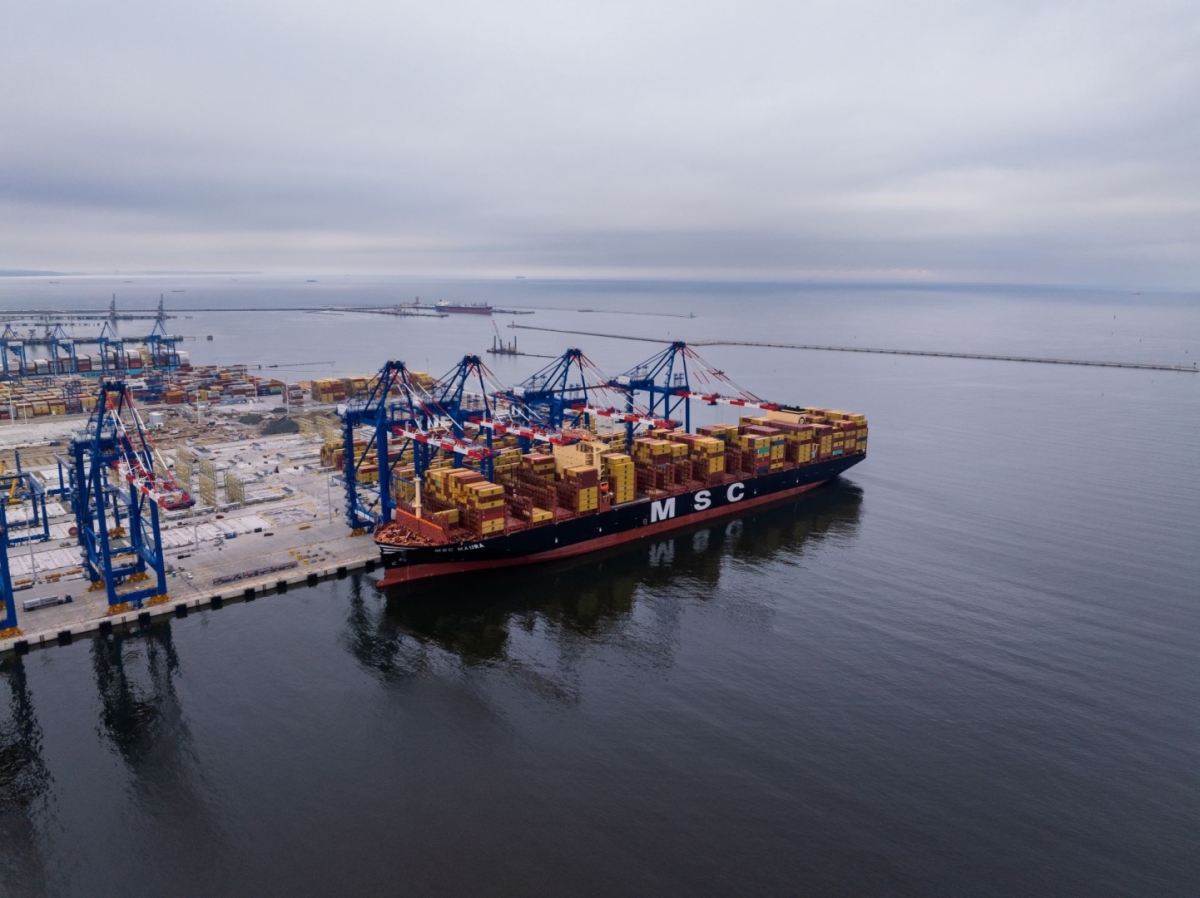
On April 22, the container vessel MSC Maura arrived at the T3 terminal in Gdańsk. This is the first ship to call at Baltic Hub under the Albatros ocean service, which connects ports in Asia and Europe. It demonstrates the interest of leading shipping lines in container transport to Polish ports.
The arrival of another container vessel operated by one of the global leaders in maritime transport, Mediterranean Shipping Company (MSC), highlights both the strategic importance of the Port of Gdańsk in global shipping and the steadily increasing handling capacity of Baltic Hub. Due to growing volumes, intensive work is underway on the launch of the new T3 quay, which is scheduled to begin regular operations in September this year. At present, test calls of container ships are taking place there. The investment is worth around PLN 2 billion, with Budimex as the general contractor.
The call of MSC Maura (IMO: 9962536) is particularly significant as it is the first vessel to arrive under the Albatros ocean service. The service ensures efficient transport of goods to and from China and South Korea. Calls at the Port of Gdańsk are to be regular, with two vessels arriving each week.
The vessel sails under the Liberian flag. It was built in 2024 at the Jiangsu Yangzi Xinfu Shipbuilding yard in China, with DNV as the classification society. The ship is 366 meters long and 51 meters wide, with a capacity of around 16,000 TEU.
A bit earlier, on April 8, the container vessel MSC Rose (IMO: 9957359) arrived at Baltic Hub as the first ship under MSC’s second service, Britannia. The Britannia Service provides a direct link between the ports of Gdańsk and Gdynia and ports in China and Vietnam, offering an alternative route for Polish exporters and importers.
Both Britannia and Albatros services are intended to strengthen the role of Gdynia and Gdańsk as key logistics hubs between Asia and Europe. They also replace other, now discontinued, MSC services such as SWAN-SENTOSA.
Currently, the Gdańsk terminal handles numerous ship calls within long-term services AEU1/LL1/FAL5/NE1 operated by the Ocean Alliance (CMA CGM, OOCL, COSCO SHIPPING, Evergreen), as well as the FAL1 service run by French shipping line CMA CGM. It should be recalled that the decision to discontinue the AE10 line, previously operated by Maersk’s ocean-going vessels, sparked much debate. This decision was linked to the Danish giant’s strategy and its cooperation with German carrier Hapag-Lloyd under the Gemini Cooperation. However, although the characteristic large Maersk blue vessels will no longer appear in Polish ports, smaller feeder ships will continue to operate shuttle connections, particularly on the Wilhelmshaven–Bremerhaven–Gdańsk route.
According to Baltic Hub, expanding the service network and maintaining strong relations with customers are key to strengthening the terminal’s position as the “main trade gateway” for Central and Eastern Europe. MSC, in turn, points out that its close cooperation with Polish ports, supported by expanding and modernizing infrastructure, “improves operational efficiency, shortens handling times, and provides greater logistics capabilities.”
Although full commissioning of the T3 quay is planned for the end of September this year, test calls and handling operations are already taking place there. In February, the first was CMA CGM Tivoli (IMO: 9961312), followed a month later by MSC Stacey (IMO: 9954759), the first container ship arriving from Asia.
This investment and the ongoing test operations are expected to create safer, more modern, and more efficient facilities for cargo handling. As part of this large-scale project, a 36-hectare artificial island has been built, featuring a maneuvering and storage yard, as well as a deepwater quay with a total length of 717 meters and depth of 18 meters. This will allow Baltic Hub to accommodate the world’s largest container vessels up to 400 meters in length. As a result, the terminal’s capacity is projected to increase by an additional 1.5 million TEU, reaching as much as 4.5 million TEU.
In 2024, the Gdańsk terminal achieved an operational result of 2,242,401 TEU, which was 191,588 TEU more than the previous year.


